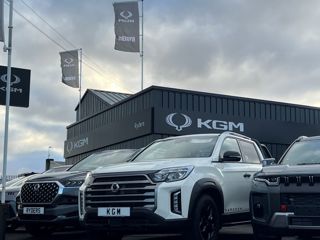When the UK’s car market is no longer in growth, carmakers typically begin to emphasise market share when they talk to the trade press – either maintaining it, or increasing it.
Data from the Society of Motor Manufacturers and Traders (SMMT) shows that 55% of brands had grown their market shares by the close of the third quarter, and 7.5% had held flat.
Among the remaining third of the market, a common thread shared by the brands that lost the most ground is a lack of resilience.
This is typically caused by over-reliance on one or two model lines within their range and a failure to prioritise longer-term sustainability over the need to pump cars into the market.
This pumping lasts only so long, until poor residual values and ageing core products leave them struggling to compete against stronger rivals able to shore up their own businesses.
Falling brands
Jeep, for example, has lost 51% of the 0.55% market share it held at this point last year.
Having previously been a brand with large, £30,000 4x4s, Jeep introduced a small SUV, the Renegade, in 2015. It put a chunk of money behind its PCP offers and watched as its annual registrations rocketed.
Two years on, the new toy in the country’s fastest growing sub-segment is no longer new. Jeep’s registrations have slumped, and its dealers have to endure a lull until early 2018, when they get the Compass, which slots in the range above Renegade. Expect the Compass to try to recover some, but not all, of Jeep’s lost share before Renegade gets a mid-life refresh.
Dealers investing in DS Automobiles, the upmarket spin-off from Citroën, must have long-term faith in the French brand’s plan to become premium and profitable, because its reliance on the old DS3 is currently causing them pain. DS’s market share has dropped 41% to 0.4%, as DS3 registrations were down 40.2% (a 4,359-unit drop) and DS4 dropped by 56.6% (1,327 units).
Citroën, too, has suffered a drop, together with the two other brands under PSA Group ownership – Peugeot and Vauxhall/Opel. Citroën’s Q1-Q3 market share has dropped 16% compared with the same period last year, to 2.1%, Peugeot’s has dropped by 13%, to 3.3%, and Vauxhall’s by 17%, to 7.8%.
One positive for their UK dealer networks, which have struggled for sustainable profits, is that PSA Group’s home market, France, appears to be absorbing some of the volume. Peugeot’s annual sales in France were up 6.9% and Citroën’s up 3.6% by the end of September. However, DS was still down, by 30.6%.
Behind Citroën’s UK woes are two of its most popular models: the C1 and C4 Cactus. The C1 has dropped by 7,774 units, while Cactus registrations are down 4,503 units. Both have fallen fastest in the fleet market, however, which suggests that last year’s result included a large chunk of short-cycle business that has not been repeated.
Peugeot’s core hatchbacks, the 208 and 308, are also responsible for its decline, down 7,533 and 4,939 units respectively. Although the 308 has just been refreshed, Peugeot dealers must wait two years until their best-selling 208 is renewed. Meanwhile, its new 3008 SUV has the potential to overtake the 208 in volume – it’s at 13,877 registrations, only 1,614 behind the 208.
Growth brands
The brands quickly growing their market share are not perfect, however.
At the top of the table, there are similar tales of inconsistency and questionable short-term sustainability in sales performance from some very small brands, where the launch of a new model makes an immediate impact.
Aston Martin has doubled its share, albeit from a very low base of 0.03%. Demand for its latest DB11 flagship remains high, with the Vantage S and Vanquish S sports tourers also doing good business.
Longer-term, its network will look to the first Aston Martin SUV, the DBX, which goes into production in 2019, to sustain their sales growth by attracting a whole new market.
Infiniti’s market share has risen, by 25% to 0.15%, as has Seat’s, to 2.1%. Both have fresh hatchbacks and crossover SUVs in the largest parts of the market, the B- and C-segments.
Infiniti’s 20 showrooms are steadily gaining viability and now have average new car throughput of 155 units in Q1-Q3 thanks to the volume provided by Q30 and QX30.
Seat dealers have welcomed the new Ibiza, which follows the success of its first SUV, the Ateca. SMMT data shows Seat’s growth is strongest in the fleet market, where it has recorded a 37% rise in registrations, to 24,553.
The increase leaves Seat as a fleet-dominated brand (55% fleet/45% retail), perhaps benefiting from the declines at Vauxhall and Peugeot, both of which have been traditionally strong fleet performers.
Sitting on either side of the middle of the table are two of the UK’s most popular brands, Ford and Volkswagen. The former’s market share has dropped by 4.2%, to 11.3%, while the latter’s has risen 5.5%, to 8%.
Ford’s decline is most pronounced in the retail market, where it pushed hard with the old Fiesta last year and has eased off now the new model has arrived. Fiesta’s retail volumes are down 27% or 16,592 units. The Focus and the Kuga have held firm, but the remainder of Ford’s car range has experienced a drop in demand – or an easing off from pushing volumes, at least. The Ka seems to be the only model getting a significant shove at present – its fleet volumes are up 213% (to 2,429 units) and retail volumes are 50% ahead (at 8,382 units).
The Tiguan leads Volkswagen’s improvement. Deliveries of the mid-sized SUV have increased by 58%, or 8,343 overall, of which 5,666 were in the fleet market.





















Login to comment
Comments
No comments have been made yet.